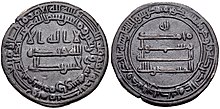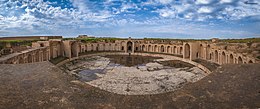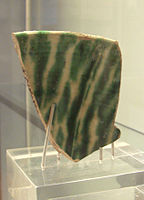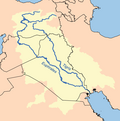Samarra
Samarra
سَامَرَّاء | |
|---|---|
City | |
 The spiral minaret of the Great Mosque of Samarra (2016) | |
| Coordinates: 34°11′54″N 43°52′27″E / 34.19833°N 43.87417°E | |
| Country | |
| Governorate | Saladin Governorate |
| Population (2003 est) | |
| • Total | 348,700 |
| Official name | Samarra Archaeological City |
| Criteria | Cultural: ii, iii, iv |
| Reference | 276 |
| Inscription | 2007 (31st Session) |
| Endangered | 2007- |
| Area | 15,058 ha |
| Buffer zone | 31,414 ha |
Samarra (
The archeological site of Samarra still retains much of the historic city's original plan, architecture and artistic relics.[2] In 2007, UNESCO designated it a World Heritage Site.[3]
History
This section needs additional citations for verification. (April 2023) |
Prehistoric Samarra
The remains of
The civilization flourished alongside the Ubaid period, as one of the first town states in the Near East. It lasted from 5,500 BCE and eventually collapsed in 3,900 BCE.
Neo-Assyrian period
A city of Sur-marrati (refounded by Sennacherib in 690 BC according to a stele in the Walters Art Museum) is insecurely identified with a fortified Assyrian site at al-Huwaysh on the Tigris opposite modern Samarra. The State Archives of Assyria Online identifies Surimarrat as the modern site of Samarra.[4]
Ancient place names for Samarra noted by the Samarra Archaeological Survey are Greek Souma (
The possibility of a larger population was offered by the opening of the Qatul al-Kisrawi, the northern extension of the
-
Female statuette, Samarra, 6000 BC
-
The Samarra bowl at the Vorderasiatisches Museum, Berlin. The swastika in the center of the design is a reconstruction.[5]
-
Chinese-made sancai pottery shard, 9th–10th century, found in Samarra, an example of Chinese influences on Islamic pottery. British Museum.
Abbasid capital

In 836

The city was further developed under Caliph al-Mutawakkil, who sponsored the construction of lavish palace complexes, such as al-Mutawakkiliyya, and the Great Mosque of Samarra with its famous spiral minaret or Malwiya, built in 847. For his son al-Mu'tazz he built the large palace Bulkuwara.

The Nestorian patriarch
Samarra remained the residence of the caliph until 892, when al-Mu'tadid returned the capital to Baghdad.[9] Historical sources report that the city was looted around this time. Its population probably decreased and the city declined, but it remained an important market center.[9]
From the tenth century onward it turned into an important pilgrimage site. During the 12th and 13th centuries, the river's course to the south of the city shifted further east. As a result, the main road between Baghdad and Mosul was moved to the west bank and Samarra lost its importance as a trading town.[9]
Modern era
In the eighteenth century, one of the most violent battles of the 1730–1735
During the 1950s, Samarra gained new importance when a permanent lake, Lake Tharthar, was created through the construction of the Samarra Barrage, which was built in order to prevent the frequent flooding of Baghdad. Many local people were displaced by the dam, resulting in an increase in Samarra's population.[10]

Samarra is a key city in Saladin Governorate, a major part of the so-called
Ever since the end of Iraqi civil war in 2007, the Shia population of the holy city has increased exponentially. However, violence has continued, with bombings taking place in
Geography
Climate
Samarra has a
| Climate data for Samarra | |||||||||||||
|---|---|---|---|---|---|---|---|---|---|---|---|---|---|
| Month | Jan | Feb | Mar | Apr | May | Jun | Jul | Aug | Sep | Oct | Nov | Dec | Year |
| Mean daily maximum °C (°F) | 15.3 (59.5) |
18.0 (64.4) |
22.1 (71.8) |
28.3 (82.9) |
35.7 (96.3) |
41.1 (106.0) |
43.9 (111.0) |
43.6 (110.5) |
39.7 (103.5) |
33.2 (91.8) |
24.4 (75.9) |
17.4 (63.3) |
30.2 (86.4) |
| Mean daily minimum °C (°F) | 4.4 (39.9) |
5.9 (42.6) |
9.3 (48.7) |
14.2 (57.6) |
19.6 (67.3) |
23.5 (74.3) |
25.9 (78.6) |
25.4 (77.7) |
21.4 (70.5) |
16.4 (61.5) |
10.6 (51.1) |
5.8 (42.4) |
15.2 (59.4) |
| Average precipitation mm (inches) | 25 (1.0) |
30 (1.2) |
29 (1.1) |
21 (0.8) |
8 (0.3) |
0 (0) |
0 (0) |
0 (0) |
0 (0) |
4 (0.2) |
20 (0.8) |
34 (1.3) |
127 (5.0) |
| Source: climate-data | |||||||||||||
Religious significance
The city is also home to
In popular culture
The metaphor of "Having an appointment in Samarra", signifying death, is a literary reference to an ancient Babylonian myth recorded in the
In the 1968 film Targets, Byron Orlok, an aging horror film star played by Boris Karloff, tells Maugham's version of the story to his younger colleagues.[23]
The story is told in "The Six Thatchers", a 2017 episode of Sherlock.
See also
References
- ISBN 9789004161658.
- ^ "Samarra Archaeological City". UNESCO World Heritage Centre. Retrieved 2023-04-24.
- ^ "Unesco names World Heritage sites". BBC News. 2007-06-28. Retrieved 2010-05-23.
- ^ SAAO
- .
- ISBN 1-86064-721-9.
- ISBN 9780300064650.
- ^ Mari, 80–1 (Arabic), 71–2 (Latin)
- ^ ISBN 978-90-04-09834-3.
- ISBN 978-1-84162-488-4.
- ^ Bazzaz, Sahar (2013). "The Discursive Mapping of Sectarianism in Iraq: The "Sunni Triangle" in the Pages of The New York Times". In Bazzaz, Sahar; Batsaki, Yota; Angelov, Dimiter (eds.). Imperial Geographies in Byzantine and Ottoman Space. Hellenic Studies Series. Washington, DC: Center for Hellenic Studies.
- ISBN 978-1-101-19206-1.
- ^ "Explosion Topples Minarets At Iraqi Shi'ite Shrine". RadioFreeEurope/RadioLiberty. 2007-06-13. Retrieved 2015-08-22.
- ^ John F. Burns; Jon Elsen (2007-06-14). "Several Mosques Attacked, but Iraq Is Mostly Calm - New York Times". The New York Times. Retrieved 2015-08-22.
- ^ Qassim Abdul-Zahra (June 13, 2007). "Iraqi police say famous shrine attacked". Associated Press.
- ^ "Blast hits key Iraq Shia shrine". BBC. 2007-06-13. Retrieved 2012-04-21.
- ISSN 0261-3077. Retrieved 2023-09-26.
- ^ Hassan, Ghazwan (5 June 2014). "Iraq dislodges insurgents from city of Samarra with airstrikes". Reuters. Retrieved 27 June 2014.
- ^ "Archnet > Site > Qubba Imam al-Dur". www.archnet.org. Retrieved 2023-04-14.
- ^ ISBN 978-1-78672-982-8.
- ^ "The Appointment in Samarra" (as retold by W. Somerset Maugham [1933]).
- ISBN 0-670-82086-5/ 0-670-82086-5).
- ^ Bogdanovich, Peter (director) (1968). Targets (DVD). United States of America: Criterion.
Selected bibliography
- De la Vaissière, Étienne (2007): Samarcande et Samarra. Élites d’Asie central dans l’empire abbaside (Studia Iranica, Cahier 35), Paris.
- Gordon, Matthew S. (2001). The Breaking of a Thousand Swords: A History of the Turkish Military of Samarra (A.H. 200–275/815–889 C.E.). Albany, New York: State University of New York Press. ISBN 0-7914-4795-2.
- Northedge, Alastair (2005): The historical topography of Samarra, London.
- Robinson, Chase (ed.) (2001): A Medieval Islamic City Reconsidered: An Interdisciplinary Approach to Samarra (Oxford Studies in Islamic Art 14). Oxford.
External links
- Ernst Herzfeld Papers, Series 7: Records of Samarra Expeditions, 1906–1945 Smithsonian Institution, Freer Gallery of Art and Arthur M. Sackler Gallery Archives, Washington, D.C.
- Ernst Herzfeld Papers, Series 7: Records of Samarra Expeditions, 1906–1945 Collections Search Center, S.I.R.I.S., Smithsonian Institution, Washington, D.C.
- Iraq Image - Samarra Satellite Observation
- Samarra Archaeological Survey
- "The Appointment in Samarra"
- Destruction of Askari Mosque
- Samarra on Google Earth



![The Samarra bowl at the Vorderasiatisches Museum, Berlin. The swastika in the center of the design is a reconstruction.[5]](http://upload.wikimedia.org/wikipedia/commons/thumb/1/1d/Samarra_bowl.jpg/197px-Samarra_bowl.jpg)


